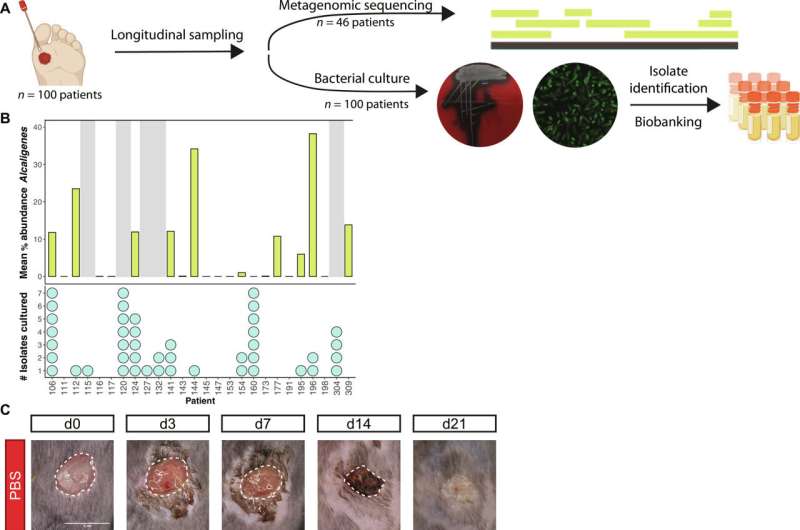This article has been reviewed according to Science X's editorial process and policies. Editors have highlighted the following attributes while ensuring the content's credibility:
fact-checked
peer-reviewed publication
trusted source
proofread
How a bacterium supports healing of chronic diabetic wounds

There are many important reasons for keeping cuts and sores clean, but new research from the Perelman School of Medicine at the University of Pennsylvania shows that a certain bacterium, Alcaligenes faecalis (A. faecalis), can facilitate healing of hard-to-treat wounds among people with diabetes. While there are many studies done on potentially harmful bacteria in wounds, the researchers discovered that A. faecalis, a bacterium found in many types of chronic wounds, actually boosts healing of diabetic wounds.
The researchers found that the beneficial bacterium can promote skin cell movements that are essential for wound closure by inhibiting enzymes that are over-produced in people with diabetes. The findings are published in Science Advances, led by Penn's Elizabeth Grice, Ph.D., the Sandra J. Lazarus Professor in Dermatology, and Ellen K. White, an MD-Ph.D. student at Penn.
The team says that uncovering the mechanisms behind how A. faecalis boosts healing could help scientists find new treatments for diabetic wounds.
"This research builds heavily on our previous research where we profiled the bacteria found in diabetic foot ulcers over time and studied how these bacteria influence healing outcomes," said Dr. Grice. "We did not expect to find that a bacterium would be able to promote healing, but this surprising finding motivated further studies of A. faecalis."
Chronic wounds, categorized by sores, ulcers, or lacerations that fail to heal or heal very slowly, are common in patients with diabetes. They can be painful, make individuals susceptible to further infection, and are linked to higher rates of morbidity and mortality. New therapies are needed to treat these debilitating wounds, but there have not been many new treatment developments which include surgical removal of dead tissue and bandaging.
To understand how A. faecalis influenced diabetic healing, the researchers did several types of tests with diabetic mice, their skin cells, and human diabetic skin samples. First, they found that using A. faecalis to inoculate diabetic mice, which have wound healing defects, led to accelerated wound healing with no signs of infection.
Next, they learned that introducing A. faecalis to wounds caused keratinocytes, the dominant wound healing cell type in the epidermis, to proliferate and migrate to close the wound more than the untreated cells. Additionally, skin samples taken from individuals who have diabetes were cultured with A. faecalis, and after 10 days, the samples with the bacterium had a statistically significant greater outgrowth of keratinocytes.
From there, the researchers saw mice diabetic wounds treated with A. faecalis turned up genes linked to the activation of leukocytes including T cells which are vital in the immune system's defense. It also downregulated genes responsible for collagen breakdown, specifically enzymes called matrix metalloproteinases (MMPs).
Importantly, there are too many MMPs in people with diabetes and have been shown to inhibit proper wound healing. The study focused particularly on MMP-10 which is expressed by keratinocytes, and was lowered in wounds treated with A. faecalis.
"MMPs are necessary enzymes that break down connections between cells to allow cells to move. But in patients with diabetes, MMPs are known to exist at much higher levels," White said.
"Our findings show that A. faecalis rebalances the MMP expression in wounds, which allows faster wound closure. In future studies we hope to learn more about how the bacteria communicates with skin cells, and also how A. faecalis interacts with other bacteria in the wound."
This new research exposes areas where scientists can explore potential therapeutics. By not only focusing on the microbes involved in the chronic wound and healing process, but also on their specific interactions, scientists could try to develop more options for wound care.
"Bacterial-based wound therapies are an exciting new frontier," said Grice.
"There are many different ways to take advantage of our findings and future work on the wound microbiome. It may be possible to isolate the pro-healing molecules secreted by A. faecalis or target the pathways that are downstream of the bacteria's effects. The better we understand the whole process, the more likely we can translate our findings to ultimately help patients with wound and skin repair problems."
More information: Ellen K. White et al, Alcaligenes faecalis corrects aberrant matrix metalloproteinase expression to promote reepithelialization of diabetic wounds, Science Advances (2024). DOI: 10.1126/sciadv.adj2020





















